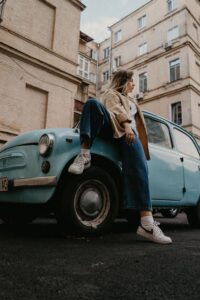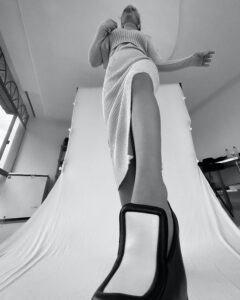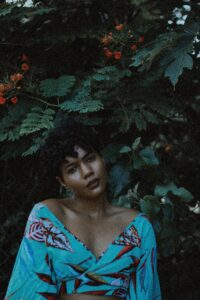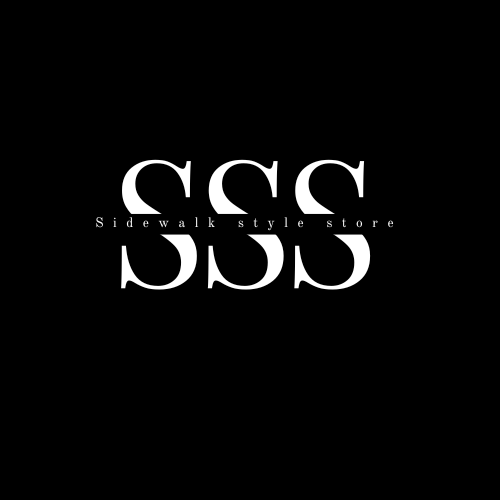RETRO FASHION
Introduction
“Retro” is a term used to describe things from the past, particularly styles, trends, or designs that were popular in previous eras. Itrefers to a nostalgic imitation or revival of trends and fashion from the past. Retro items are often inspired by specific historical periods and reflect the styles, colors, and designs of that time.In the context of fashion, retro clothing refers to garments that are designed in a style reminiscent of a particular period in the past. These designs capture the essence of that era and often incorporate elements such as fabrics, cuts, patterns, and accessories that were fashionable during that time.Apart from fashion, the term “retro” can be applied to various other aspects of culture, including music, interior design, technology, and even art. For example, retro music might refer to the revival of musical styles from the 1960s or 1970s, while retro furniture could describe designs inspired by mid-century modern aesthetics.Retro items are popular because they allow people to revisit the past and experience a sense of nostalgia. They often serve as a bridge between the past and the present, blending vintage charm with contemporary sensibilities.
previous eras. Itrefers to a nostalgic imitation or revival of trends and fashion from the past. Retro items are often inspired by specific historical periods and reflect the styles, colors, and designs of that time.In the context of fashion, retro clothing refers to garments that are designed in a style reminiscent of a particular period in the past. These designs capture the essence of that era and often incorporate elements such as fabrics, cuts, patterns, and accessories that were fashionable during that time.Apart from fashion, the term “retro” can be applied to various other aspects of culture, including music, interior design, technology, and even art. For example, retro music might refer to the revival of musical styles from the 1960s or 1970s, while retro furniture could describe designs inspired by mid-century modern aesthetics.Retro items are popular because they allow people to revisit the past and experience a sense of nostalgia. They often serve as a bridge between the past and the present, blending vintage charm with contemporary sensibilities.
What is Retro fashion
Retro fashion refers to fashion trends and styles that draw inspiration from the past. Unlike vintage clothing, which is clothing from a specific era, retro fashion incorporates elements from various time periods into modern designs. It’s a nostalgic nod to the fashion of the past, often reinterpreted and combined with contemporary aesthetics.“In the realm of fashion, time becomes an endless loop, weaving together the threads of the past with the tapestry of the present. Retro fashion stands as a vivid testament to this beautiful interplay, offering a treasure trove of styles that pay homage to iconic moments in history. Step into an era where every silhouette, color palette, and accessory tells a story—a story of rebellion, sophistication, glamour, and revolution.From the grace and poise of Audrey Hepburn’s timeless elegance to the rebellious spirit embodied in the denim-clad ’70s, retro fashion transcends decades, inviting us to rediscover and reimagine the essence of fashion’s golden ages. It’s a celebration of iconic pieces that have stood the test of time and continue to inspire the way we dress today.Immerse yourself in the swing of the ’60s, where psychedelic prints and mini-skirts took center stage, or relish the opulence and drama of the ’80s, where power dressing redefined fashion norms. Each era holds its distinct charm, inviting us to explore, reinterpret, and infuse our modern wardrobes with a touch of timeless nostalgia.Join us as we journey through the annals of fashion history, embracing the elegance, boldness, and sheer creativity that continue to shape our contemporary sense of style. Retro fashion isn’t just a nod to the past—it’s a celebration of enduring trends and a testament to the cyclical nature of fashion’s ever-evolving narrative.”
which is clothing from a specific era, retro fashion incorporates elements from various time periods into modern designs. It’s a nostalgic nod to the fashion of the past, often reinterpreted and combined with contemporary aesthetics.“In the realm of fashion, time becomes an endless loop, weaving together the threads of the past with the tapestry of the present. Retro fashion stands as a vivid testament to this beautiful interplay, offering a treasure trove of styles that pay homage to iconic moments in history. Step into an era where every silhouette, color palette, and accessory tells a story—a story of rebellion, sophistication, glamour, and revolution.From the grace and poise of Audrey Hepburn’s timeless elegance to the rebellious spirit embodied in the denim-clad ’70s, retro fashion transcends decades, inviting us to rediscover and reimagine the essence of fashion’s golden ages. It’s a celebration of iconic pieces that have stood the test of time and continue to inspire the way we dress today.Immerse yourself in the swing of the ’60s, where psychedelic prints and mini-skirts took center stage, or relish the opulence and drama of the ’80s, where power dressing redefined fashion norms. Each era holds its distinct charm, inviting us to explore, reinterpret, and infuse our modern wardrobes with a touch of timeless nostalgia.Join us as we journey through the annals of fashion history, embracing the elegance, boldness, and sheer creativity that continue to shape our contemporary sense of style. Retro fashion isn’t just a nod to the past—it’s a celebration of enduring trends and a testament to the cyclical nature of fashion’s ever-evolving narrative.”
Here are some popular retro fashion styles from different decades:
1.1920s Retro (Flapper Era):
-
- Cloche hats
- Drop-waist dresses
- Beaded and fringed embellishments
- Mary Jane shoes
- Art Deco jewelry
2.1940s Retro (WWII Era):
-
- A-line dresses
- High-waisted pants
- Peplum tops
- Victory rolls hairstyles
- Platform shoes
3.1950s Retro (Rock ‘n’ Roll Era):
-
- Poodle skirts
- Crop tops and high-waisted shorts
- Cat-eye glasses
- Bobby socks and saddle shoes
- Greaser-inspired leather jackets
4.1960s Retro (Mod Era):
-
- Mini skirts
- Shift dresses
- Go-go boots
- Bold geometric patterns
- Psychedelic prints
5.1970s Retro (Disco Era):
-
- Bell-bottom pants
- Wrap dresses
- Halter necklines
- Platform shoes
- Wide collars and lapels
6.1980s Retro (New Wave Era):
-
- Shoulder pads
- Acid-washed jeans
- Off-the-shoulder tops
- Leg warmers
- Neon colors and bold prints
7.1990s Retro (Grunge and Hip-Hop Era):
-
- Flannel shirts
- Crop tops and high-waisted jeans
- Slip dresses over T-shirts
Chunky sneakers- Chokers and hoop earrings
Early 2000s Retro (Y2K Era):
-
- Low-rise jeans
- Rhinestone-embellished clothing
- Cargo pants and skirts
- Velour tracksuits
- Butterfly clips and colorful accessories
Aspects of retro fashion 
Certainly! Retro fashion continues to be a popular and influential trend, often blending elements from vario
us decades to create unique and stylish looks. Here are some more aspects of retro fashion that might interest you:
1. Mixing Eras:
Retro fashion enthusiasts often mix styles from different decades. For instance, pairing a 1950s-style dress with 1980s accessories or combining 1960s mod clothing with 1990s grunge elements. This mixing of eras allows for creative and personalized fashion statements.
2. Retro Accessories:
Accessories play a crucial role in retro fashion. Examples include cat-eye sunglasses from the 1950s, chunky jewelry from the 1980s, or headscarves reminiscent of the 1960s. These accessories are often used to add a vintage touch to modern outfits.
3. Retro Hairstyles and Makeup:
Retro hairstyles and makeup techniques are often revived to complement the fashion. Victory rolls from the 1940s, beehive hairdos from the 1960s, or the grunge-inspired messy hair of the 1990s are popular. Makeup styles, such as winged eyeliner from the 1950s or bold, dark lips from the 1920s, also contribute to the overall retro look.
4. Influence on Modern Designers:
Many contemporary fashion designers draw inspiration from retro styles. Runway shows often feature designs that pay homage to specific decades. Designers reinterpret vintage fashion, giving it a modern twist and introducing it to new generations.
5. Pop Culture and Retro Fashion:
Movies, TV shows, and celebrities often influence retro fashion revivals. Period films and series, like “Mad Men,” have sparked renewed interest in 1960s fashion. Celebrities embracing retro styles in their red-carpet appearances also contribute significantly to the popularity of vintage looks.
6. Online Thrifting and Vintage Shops:
The rise of online marketplaces and vintage shops has made it easier for people to access authentic retro clothing and accessories. Websites and apps dedicated to vintage fashion allow enthusiasts to explore and purchase items from different eras.
7. Sustainability and Retro Fashion:
The sustainability movement has also contributed to the popularity of retro fashion. Vintage and second-hand clothing are seen as sustainable choices, promoting the reuse of garments and reducing the environmental impact of fast fashion.
Retro fashion in present day
Retro fashion continues to make waves in the present day! It’s fascinating how elements from past decades continue to influence and inspire modern-day fashion.In today’s fashion landscape, retro styles continue to thrive, offering a delightful blend of nostalgia and contemporary flair. From runways to streetwear, the influence of past eras remains a vibrant
 force, reinterpreted and embraced by fashionistas worldwide. Designers infuse modern collections with echoes of retro aesthetics, reviving iconic silhouettes, patterns, and color palettes from bygone decades.The resurgence of vintage clothing stores and online marketplaces has fueled a renewed interest in retro fashion, allowing individuals to curate their wardrobes with pieces that exude timeless charm. The versatility of retro fashion is evident as it seamlessly integrates into everyday wear, from the resurgence of high-waisted jeans and flared pants to the revival of bold patterns, oversized silhouettes, and statement accessories reminiscent of past epochs.
force, reinterpreted and embraced by fashionistas worldwide. Designers infuse modern collections with echoes of retro aesthetics, reviving iconic silhouettes, patterns, and color palettes from bygone decades.The resurgence of vintage clothing stores and online marketplaces has fueled a renewed interest in retro fashion, allowing individuals to curate their wardrobes with pieces that exude timeless charm. The versatility of retro fashion is evident as it seamlessly integrates into everyday wear, from the resurgence of high-waisted jeans and flared pants to the revival of bold patterns, oversized silhouettes, and statement accessories reminiscent of past epochs.
Here’s how retro fashion is thriving in today’s trends:
- Reimagined Classics: Designers often reinterpret classic silhouettes and styles from past eras, infusing them with modern elements. For instance, a 1950s-inspired tea dress might be updated with contemporary prints or fabrics.
- Vintage Revival: Vintage clothing and accessories are highly sought after. There’s a thriving market for authentic vintage pieces, and many modern retailers offer vintage-inspired collections that capture the essence of different eras.
- Mixing Eras: Fashion enthusiasts love mixing and matching pieces from various decades to create eclectic, personalized looks. It’s not uncommon to see someone pairing a ’70s-inspired blouse with ’90s-style jeans and accessorizing with ’60s jewelry.
- Celebrity Influence: Celebrities often embrace retro fashion, bringing iconic styles from the past into the spotlight. Their red carpet appearances or street style choices can significantly impact current trends and encourage others to try vintage-inspired looks.
- Sustainable Fashion: The emphasis on sustainability has boosted the popularity of retro fashion. Vintage shopping and upcycling old garments align with the movement toward more eco-friendly and ethical fashion choices.
- Social Media and Influencers: Social media platforms and fashion influencers play a significant role in promoting retro styles. They showcase how to incorporate vintage pieces into everyday outfits and inspire their followers to experiment with nostalgic fashion.
How to style a retro fashion look

Creating a captivating retro fashion look involves a harmonious fusion of iconic elements from past decades with contemporary twists that reflect your personal style. Begin by curating key pieces from vintage stores, online platforms, or family heirlooms, selecting garments that encapsulate the spirit of your chosen era.Assembling an outfit is akin to storytelling; aim for cohesion and balance. Mix and match tailored pieces with flowing silhouettes, experiment with contrasting colors and textures, and layer different garments to create depth and dimension. Don’t shy away from blending eras—a modern blazer over a ’60s-inspired shift dress or a retro-style jacket layered atop a basic tee and jeans can infuse character into your look.Accessories are your allies in capturing the essence of a retro era. Embrace statement accessories like wide-brimmed hats, bold scarves, oversized sunglasses, or vintage-inspired jewelry to add flair. Footwear plays a pivotal role—choose shoes that complement your ensemble, be it Mary Janes, loafers, or chunky heels that echo the era you’re channeling. Here’s a step-by-step guide to help you achieve a retro-inspired look:
- Choose Your Era: Select a specific era or combine elements from different decades that resonate with your style. Whether it’s the sleek ’50s, groovy ’60s, disco ’70s, or bold ’80s, each era has its unique fashion elements.
- Start with Key Pieces: Identify iconic items from your chosen era. For example, a poodle skirt and a fitted cardigan for a ’50s look, bell-bottom jeans and a peasant blouse for a ’70s vibe, or a power suit with exaggerated shoulders for an ’80s ensemble.
- Mix Old with New: Pair vintage or retro pieces with contemporary clothing to create a modern twist. Combine a vintage blouse with modern jeans or a retro skirt with a current top to blend eras seamlessly.
- Accessorize Thoughtfully: Accessories are essential in nailing a retro look. Add headscarves, statement belts, chunky jewelry, cat-eye sunglasses, or vintage-inspired handbags to complement your outfit and evoke the chosen era.
- Pay Attention to Hairstyles and Makeup: Hairstyles and makeup can significantly enhance the retro vibe. Experiment with hairstyles like victory rolls, pin curls, or slick ponytails, and try makeup looks from the era you’re channeling, such as winged eyeliner or bold lipstick.
- Consider Colors and Patterns: Retro fashion often features vibrant colors and bold patterns. Embrace polka dots, florals, stripes, or geometric designs that were popular during the era you’re drawing inspiration from.
- Choose the Right Footwear: Complete your look with era-appropriate footwear. Opt for saddle shoes, pumps, platform sandals, or chunky sneakers that complement the era you’re styling.
- Confidence and Attitude: Lastly, rock your retro look with confidence and attitude. Embrace the style, have fun experimenting, and don’t be afraid to add your unique touch to make the outfit your own.
Retro Makeup
Creating a retro-inspired makeup look involves channeling the distinct styles of past eras while adapting them to suit modern tastes. Here’s a breakdown for a few popular retro makeup looks:
- 1950s Retro Makeup:
- Complexion: Aim for a flawless, matte complexion with a light foundation or powder. Opt for a natural, rosy blush on the apples of your cheeks.
- Eyes: Define your brows with a slightly arched shape. For eyes, go for neutral eyeshadows with a defined crease and a winged eyeliner. False lashes or mascara to enhance the lash line.
- Lips: Emphasize the lips with a bold red lipstick, typically in a matte or satin finish. Overdrawn lips were also common in this era.
- 1960s Retro Makeup:
- Complexion: A natural and radiant complexion was favored. Use light foundation or BB cream for a dewy finish.
- Eyes: Focus on dramatic eyes with defined creases, bold eyeliner (often with a dramatic wing), and lots of mascara. White or nude eyeshadow shades were trendy.
- Lips: Experiment with nude or pale lip colors, often paired with a slightly frosted finish. Alternatively, bold, mod-inspired lipstick shades like pale pinks or corals were also popular.
- 1970s Retro Makeup:
- Complexion: A sun-kissed look with bronzer was typical. Opt for a bronzer or warm blush to give a healthy glow.
- Eyes: Embrace earthy tones like browns, oranges, or golds for eyeshadow. Define eyes with soft eyeliner and finish with thick lashes using mascara.
- Lips: Choose warm, earthy tones or glossy lips. Lip gloss was popular, and shades like browns, oranges, or deep reds were trendy.
- 1980s Retro Makeup:
- Complexion: Vibrant and bold, often with colorful blush placed high on the cheeks.
- Eyes: Think bold and colorful eyeshadows with blues, purples, or even neons. Experiment with exaggerated eyeshadow shapes and heavy eyeliner.
- Lips: Bold and bright lip colors were iconic—think electric pinks, reds, or purples. Matte lipstick or glossy finishes were both fashionable.
